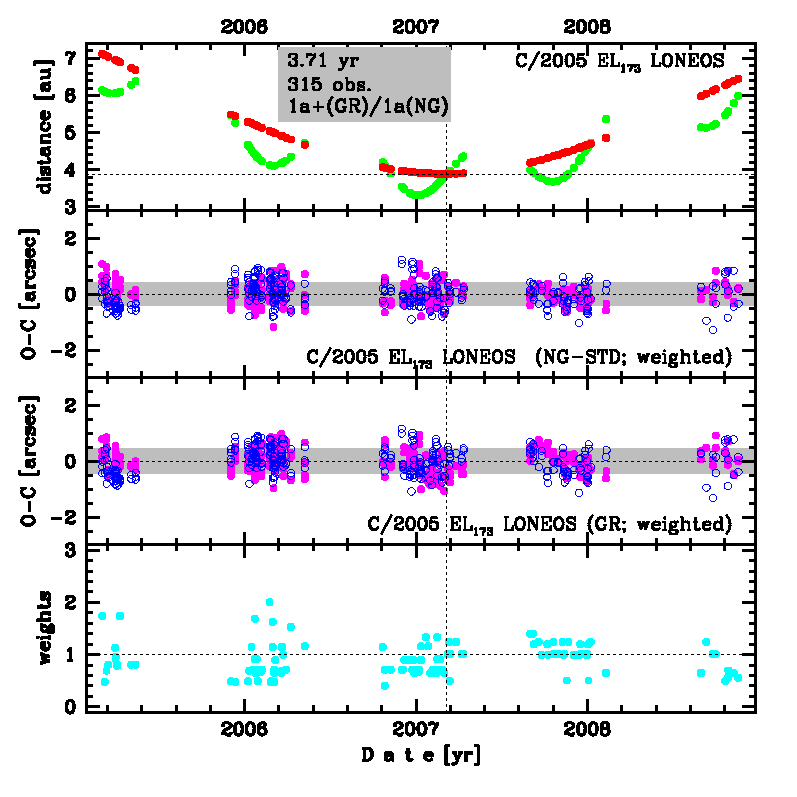C/2005 EL173 LONEOS
more info
C/2005 EL173 was discovered on 8 March 2005 by the LONEOS as an apparently asteroidal object in a retrograde orbit and semimajor axis of 36 au [MPEC 2005-F48, 2005 March 29]. Therefore it was initially classified as cubewano or scattered disc object in MPC. Its cometary apperance was reported by A. Fitzsimmons on 10 May 2005. C/2005 EL173 was observed until mid-November 2008.
This comet made its closest approach to the Earth on 4 January 2007 (3.310 au), two months before perihelion passage.
Solutions given here are based on data spanning over 3.7 yr in a range of heliocentric distances: 7.12 au – 3.886 au (perihelion) – 6.45 au.
NG orbit using full data-arc is determinable.
This Oort spike comet suffers rather slight planetary perturbations during its passage through the planetary system; however, these perturbations leas to escape this comet from the planetary zone on a hyperbolic orbit.
See also Królikowska and Dones 2023, Królikowska and Dybczyński 2017,and Królikowska 2014.
This comet made its closest approach to the Earth on 4 January 2007 (3.310 au), two months before perihelion passage.
Solutions given here are based on data spanning over 3.7 yr in a range of heliocentric distances: 7.12 au – 3.886 au (perihelion) – 6.45 au.
NG orbit using full data-arc is determinable.
This Oort spike comet suffers rather slight planetary perturbations during its passage through the planetary system; however, these perturbations leas to escape this comet from the planetary zone on a hyperbolic orbit.
See also Królikowska and Dones 2023, Królikowska and Dybczyński 2017,and Królikowska 2014.
| solution description | ||
|---|---|---|
| number of observations | 315 | |
| data interval | 2005 03 03 – 2008 11 17 | |
| data type | perihelion within the observation arc (FULL) | |
| data arc selection | entire data set (STD) | |
| range of heliocentric distances | 7.12 au – 3.89 au (perihelion) – 6.45 au | |
| type of model of motion | NS - non-gravitational orbits for standard g(r) | |
| data weighting | YES | |
| number of residuals | 627 | |
| RMS [arcseconds] | 0.42 | |
| orbit quality class | 1a | |
| orbital elements (heliocentric ecliptic J2000) | ||
|---|---|---|
| Epoch | 2007 03 01 | |
| perihelion date | 2007 03 05.87120140 | ± 0.00020637 |
| perihelion distance [au] | 3.88631363 | ± 0.00000363 |
| eccentricity | 1.00333117 | ± 0.00000427 |
| argument of perihelion [°] | 261.493496 | ± 0.000037 |
| ascending node [°] | 344.796394 | ± 0.000008 |
| inclination [°] | 130.679627 | ± 0.00001 |
| reciprocal semi-major axis [10-6 au-1] | -857.16 | ± 1.10 |

Upper panel: Time distribution of positional observations with corresponding heliocentric (red curve) and geocentric (green curve) distance at which they were taken. The horizontal dotted line shows the perihelion distance for a given comet whereas vertical dotted line — the moment of perihelion passage.
Middle panel(s): O-C diagram for a given solution (sometimes in comparison to another solution available in CODE), where residuals in right ascension are shown using magenta dots and in declination by blue open circles.
Lowest panel: Relative weights for a given data set(s).
Middle panel(s): O-C diagram for a given solution (sometimes in comparison to another solution available in CODE), where residuals in right ascension are shown using magenta dots and in declination by blue open circles.
Lowest panel: Relative weights for a given data set(s).
| non-gravitational parameters | ||
|---|---|---|
| A1 [10-8au/day2] | 6140.2 | ± 932.8 |
| A2 [10-8au/day2] | -3617.9 | ± 553 |
| A3 [10-8au/day2] | 0 | (assumed) |
| m | -2.15 | |
| n | 5.093 | |
| k | -4.6142 | |
| r0 [au] | 2.808 | |
| α | 0.1113 | |